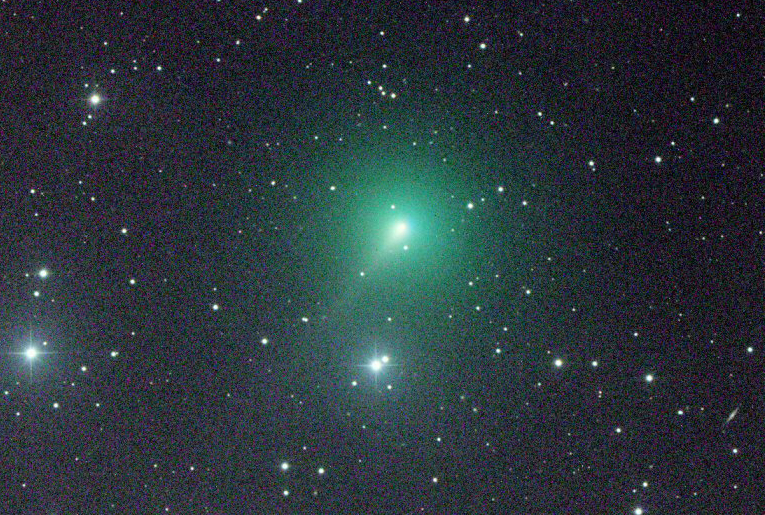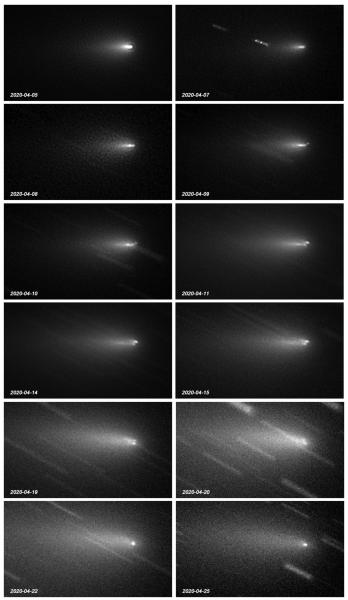The fragmentation of C/2019 Y4 (ATLAS)
2020 June 3

C/2019 Y4 was discovered by the Asteroid Terrestrial-impact Last Alert System (ATLAS) on 2019 Dec 28 using a 0.50m Wright–Schmidt telescope on Mauna Loa, Hawaii. ATLAS uses two such telescopes to obtain high-cadence, wide-field images of the sky. It is designed to find small incoming objects in the last few days before impacting Earth, but it is also very good at finding comets.
Shortly after discovery, the orbit was computed and this showed that the comet would reach perihelion on 2020 May 31 at a distance, q, of only 0.25au from the Sun. The current period is around 5,500 years and the German comet observer Maik Meyer pointed out that the orbit is very similar to that of the Great Comet of 1844 (C/1844 Y1). It appears that C/2019 Y4 and C/1844 Y1 are both fragments of a larger parent body which may have broken up at the previous perihelion 5,100 years ago,1 although fragmentations are also possible far from perihelion.
Fragmenting comet nuclei are relatively common. We know that, historically, all of the members of the Kreutz sungrazer group came from the same parent body. We have observed a number of fragmentation events, most notably the break-up of D/1993 F2 (Shoemaker–Levy) prior to its impact on Jupiter in 1993 and, more recently, the cascading fragmentation of 73P/Schwassmann–Wachmann at its returns in 2006 and 2017.
Comet nuclei are generally rather weak agglomerations of ices and refractory materials. Tidal, thermal and rotational stresses can overwhelm their gravitational and structural binding forces causing fragmentation to occur. The fragmentation can be survivable, as in the case of 73P, or catastrophic, as in the case of C/2012 S1 (ISON) which was ripped apart by tidal forces at perihelion in 2013 November, leaving only a dissipating trail of dust.
It is thought that most fragmentations are benign events which give rise to the components separating at rather low relative velocities (a few metres per second). Active surfaces on the sunward side of the fragments then produce rocket forces (non-gravitational forces or NGFs) that accelerate the low-mass fragments away from the remaining nucleus approximately along the Solar radius vector, i.e. in the general direction of the tail.
During February and early March, C/2019 Y4 brightened rapidly and hopes were raised that this could become a very nice object in the evening twilight around the end of May. Certainly in March it was a good target in wide-field, fast imaging systems (Figure 1). Indeed I used the first ever BAA webinar to discuss the prospects for the object, giving a range of possibilities – none of which included the possibility that this fragment of a comet would fragment again.
The fragmentation unfolds
The first indication that something was happening to the nucleus was that the magnitude of the central part of the coma began to stagnate. This was reported by Denis Buczynski on Mar 19 (private email) and by the Spanish Cometas-Obs group.
At around the same time the astrometric residuals (i.e. the difference between the observed and predicted positions) began to grow, as shown in Figure 2. This plot shows the astrometric residuals in RA and Dec., using an orbit prediction based on all the astrometry up to Mar 25 and computed using Bill Gray’s FindOrb. It can be seen that the RA residual increases rapidly through the last part of March. The direction of this error was in the position angle (PA) of the tail.
What we were seeing was the fragmentation occurring, with large amounts of material moving down the tail, but at scales below the resolution of our imaging systems. As a result the astrometry was biased tailward. This is also shown in the brightness profile of a slice through the brightest part of the comet, parallel with the tail (Figure 3). This figure shows the evolution of this profile from Mar 25 through to Apr 8. The peak brightness of the coma dropped by a factor of 10 over this time and it became much broader.
By Apr 6, the components of the fragmentation had separated sufficiently that they could be resolved in high-resolution images. The first amateur imager to show details of the break-up that I am aware of was Nick Haigh, from Southampton. Nick used techniques usually applied by planetary imagers (stacking a very large number of short exposures and using iterative sharpening techniques in post-processing) to produce images of very high quality. His image of Apr 6.9 shows three components.
Over subsequent days, a combination of very good UK weather, the COVID-19 lockdown and the fact that the comet was near the zenith meant that observers had an opportunity to image the fragmentation on most nights in good seeing conditions. Images showing the resolved fragments were received from Haigh, Tickner, Buczynski, Miles, Birtwhistle and others.
My sequence from Apr 5–25 shows the evolution of the various components over that time (Figure 5). Of note is the sudden appearance of a fragment to the NW (ahead and above), the extended coma on Apr 9 and its subsequent drift down the tail. This fragment could be tracked for at least 12 days.

Once the components had separated sufficiently, it was possible to perform astrometry on them. Various groups adopted different nomenclatures for the components, which made combining astrometry difficult. Within the BAA we used the designations marked on the Faulkes image shown in Figure 6. Astrometry of the components post-break-up was received from Buczynski, Miles, Birtwhistle, Storey, Hawley, Pratt and Mickleburgh. The astrometry of the individual components was used by the Minor Planet Center to produce orbits for the four main ones (A–D) but, by the time the Minor Planet Electronic Circular came out,2 only A and B were still active. Images released by the Hubble Space Telescope obtained on Apr 20 & 23 show multiple fragments, but the two groups corresponding to A and B are clear (Figure 7).

At the time of writing, fragment B appears reasonably stable and it will be interesting to see if it survives all the way to perihelion and beyond. It is possible to link the pre-Mar-26 astrometry of the original comet with the post-Apr-8 astrometry of fragment B. We get good residuals if we adopt a fairly significant radially outward non-gravitational parameter (A1= +2.31×10–7 ± 3.1×10–9 au/d2). This is very similar to the NGF calculated by Hui & Ye.1

This comet may not be the bright object that we had hoped for, but it has certainly been a fascinating object to observe and is the subject of a great demonstration of amateur observing skills.
References
1 Hui M.-T. & Ye Q.-Z., ‘Observations of disintegrating long-period comet C/2019 Y4 (ATLAS) – a sibling of C/1844 Y1’: arxiv.org/abs/2004.10990, 2020
2 MPEC 2020-H28: bit.ly/2WLxhSP
https://britastro.org/wp-content/uploads/2020/06/Figures.JPG
https://britastro.org/wp-content/uploads/2020/06/figx.JPG
| The British Astronomical Association supports amateur astronomers around the UK and the rest of the world. Find out more about the BAA or join us. |
